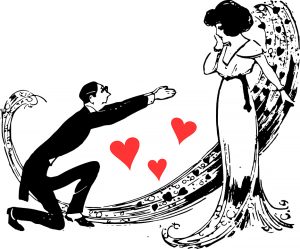Valentine’s Day, the inspired capitalist fabrication of greeting card makers, florists, and chocolatiers, happens next Wednesday. Here are some notions about wine to titillate your cherished someone.
This is something of a sweet and soft day, so shy away from dry, acidic whites. Sauvignon blanc is a splendidly versatile food wine, but anything that sometimes is described as a razor on the tongue is anything but soft and cuddly. Same goes for monster cabs. Brusque masculinity does not play well on Valentine’s day.
So, what does play?
• Rosé is almost a cliché. A dozen roses and a bottle of Provence rosé—classic. There is a palette of choices to suit your sweetheart’s palate—dry rosés, sweeter rosés, or even a white zinfandel (which is a rosé/blush wine).
• Kinder, gentler reds:
Lambrusco is among the lightest reds, has a bit of bubbles, and tastes of strawberries and blueberries.
Pinot noir is the benchmark light red wine.
Gamay is similar to pinot noir, tastes of cherry and banana.
Cinsault has meaty, savory elements; show off, and maybe be suggestive, by pronouncing it correctly: “sin-so.”
Primitivo/zinfandel—primitivo in Italy, zin in California, same grape. Relatively light wine. Raspberry jam flavors. Often high alcohol for what its worth on Valentine’s.
Grenache/garnacha—light body, strawberries, major component of Provence rosés
• Sparkling wine. You can go big bucks Champagne, or dial it back with a domestic from California, New York Finger Lakes, west coast in general at half the price of Champagne. Gruet from New Mexico is splendid with a range of styles, most under $20. If you must go cheaper, cava from Spain or prosecco from Italy come into play. Sparkling prosecco has a blush of sweetness and its affordable cost helps offset the cost of the dozen roses.
• Sweet wines for your sweetie. If your sugar likes sugar, consider moscato wines—Moscato d’Asti is sparkling. Look for sparkling wines labeled demi-sec. Gewürztraminer, chenin blanc, viognier, riesling all come in sweeter versions (caution, they also are made dry). Ice wines, sauternes, tokaji can be rich and sweet, also expensive. Wines labeled “late harvest” can be counted on to be sweet—winemakers harvest early for dryness, late for concentrated sugar and fruitiness. The best sweet wines are balanced by acidity.
Final thought: if you know your darling and her taste in wine, you can never go wrong by pouring what she/he loves.
Last round: “She tore my valentine into two pieces,” Tom said halfheartedly. “Fortunately, I had not given her the rosé wine yet, so I drank the whole bottle myself.”


